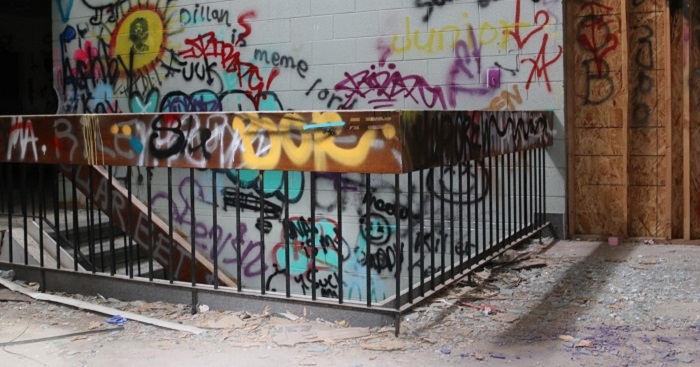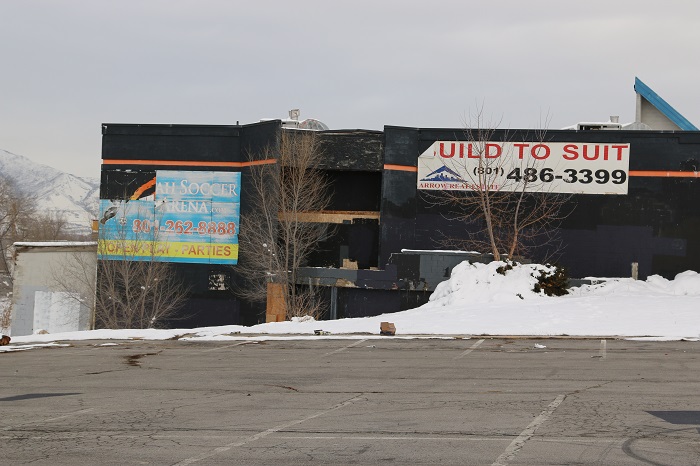
Residents living on the south side of Cottonwood Apartments near 4700 South and 900 East could hear and were sometimes awoken over the past six months by loud construction sounds, but many were unaware of what was occurring just across Little Cottonwood Creek.
Some who ventured over to the abandoned business complex at 965 East Murray Holladay Rd. to walk their dogs or just out of curiosity would encounter panhandlers, graffiti on buildings, which had broken windows and extinguished campfires with empty booze pints, needles, and other litter peppered around the area.
The homeless problem that has spiraled out of control downtown for years—and still exists even after the launch of Operation Rio Grande in August 2017—has been spreading to the suburbs and canyons.
 In this particular area, near the corner of 900 East and Van Winkle Expressway, development company J Fisher has demolished the abandoned office complex, which traded hands between multiple owners and was left vacant for several years, and is building a 48-Unit, 2.5-acre townhome development, where rents will run about $1,700. The company also has started low-income housing projects downtown and has plans for others in the Valley. To qualify, renters must make less than 60 percent of the median area’s average income.
In this particular area, near the corner of 900 East and Van Winkle Expressway, development company J Fisher has demolished the abandoned office complex, which traded hands between multiple owners and was left vacant for several years, and is building a 48-Unit, 2.5-acre townhome development, where rents will run about $1,700. The company also has started low-income housing projects downtown and has plans for others in the Valley. To qualify, renters must make less than 60 percent of the median area’s average income.
“We have bought blighted or underused properties and worked with the city and neighbors to make them better properties,” said Adam Paul, a J Fisher partner. “We like to present solutions to problems for the community. It’s no secret that there is a big housing crisis now.”
But it wasn’t easy to get squatters out of the area; and the problems there were well-known to police, who responded to calls for drug usage, stolen property, and other crimes, according to Unified Police Department Salt Lake Public Information Officer, Kent Hansen.
Transients are proliferating into other suburban areas too, causing other difficulties, including a large warehouse fire near 4500 South and 300 West on October 12 last year, which led to 30-foot flames, disrupting traffic and burning down a flammable abandoned building.
Businesses around the J Fisher development are glad the transients are gone but realize the homeless will just move elsewhere. O’Reilly Auto Parts (4687 South and 900 East) sales clerk Mark Morris said it was commonplace before the buildings were razed to see syringes in the bushes and grass and people.
“Sometimes they would camp out in front and ask for money and charge their phones,”—often bothering or scaring some customers—“my manager had to run them off sometimes,” he said.
So what is being done, especially with colder weather, to find the suburban homeless and hopefully help and relocate them?
They are welcome at the Road Home shelter downtown, where emergency doors are always open, said Spokeswoman Alicia Gleed. But Sarah Strang, division director of homeless services with the Volunteers of America (VOA) Utah, said there are many people who are hesitant to go to shelters and instead move to outlying areas. As the temperatures dip, the VOA has a team of outreach workers who go out into the community and find homeless people camping.
“We hear from community partners and citizens and try to engage them to access services to achieve housing,” Strang said. “Many of them are suffering from mental-health problems, and the lack of affordable housing is out of reach. And they don’t want to go to the shelters.”
They bring socks, sleeping bags, clothing, food, and other supplies; and try to get them supportive services and find housing. From July–November 2017, the VOA helped 750 clients, but not everyone wants assistance and new camps spring up regularly.
“Unfortunately, with some homeless experiencing mental-health issues, they are resistant to seek shelter and migrate to other places,” Strang said. “It’s a very vicious cycle they are caught up in.”
In late January, the VOA was scheduled to head out to areas unfit for human habitation one morning between three and four and conduct a point-in-time count, required by the U.S. Department of Housing and Urban Development (HUD), to assess the number of unsheltered homeless. It’s an uphill battle, Strang said, but, “we have been seeing an increase in clients who were camping and going to stay in the shelters and accessing services.”





